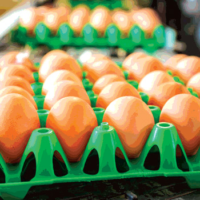Being the Third Eye in a Plant with a Problem - Listeria, Salmonella, Extraneous Materials, or Worse?

I’ve been in hundreds of plants. Because my profession is food microbiology, the reason was usually to solve a microbiological problem. Through observation and perseverance, most microbiological problems can be identified and solved with simple corrections and diligent oversight.
Bernie Surkiewitz, a mentor to many, conducted microbiological surveys for both the U.S. Food and Drug Administration and for The U.S. Department of Agriculture Food Safety and Inspection service (FSIS) for decades. The best advice he offered was to watch what workers’ hands touch: That’s where cross-contamination happens. A classic example was a burrito line with a contamination problem. The workers practiced excellent hand sanitation because they hand-rolled the burritos and used a dab of water to seal them (this was before cheap plastic gloves). Watching their hands showed that when they left the line, they grabbed their stool to scoot it away. When they returned to the line, they grabbed the stool again to bring it close to the line. A quick look at the stool seat bottoms showed festering burrito dough on the seat bottoms. (That’s something to think about when you sit down and scoot your chair closer to a restaurant table.)
Based on Bernie’s advice, one of my usual tactics when visiting a plant is to go out on the floor and watch the workers. Before Listeria, in ready-to-eat plants, I could bring a newspaper or magazine and pretend to read it so the workers would begin to ignore me. Now, I stand still and look bored. In slaughter plants, the workers are too busy to watch me. I watch where workers’ hands and their tools touch, and how they sanitize their hands when entering—and leaving—the area. Particularly in ready-to-eat plants, I watch what their frocks or aprons touch.
Another practice is to visit overnight sanitation and the morning pre-op. Some plant managers will give you a funny look and remark, “That starts at 4:00 a.m.”…or earlier. But that’s part of the job when trying to track down the source of a problem. As a consultant, you serve at the pleasure of the management, and someone will often accompany you to the line; that is an advantage. They will know the plant’s outline, product flow, and sanitary procedures.
In the “olden days” when I worked for FSIS, a plant visit the night before was a must. I’d check in with the overnight inspector, head for the floor, and chat up the sanitation crew (some Spanish fluency was often handy) and see if they were doing something special. Once the answer was “Si, some hombre from DC is coming mañana.”
Especially for Listeria monocytogenes problems, I watch the sanitation crew’s high-pressure hose operators. It is amazing how high they can throw floor debris. Look at overhead pipes and conduits for dangling bits (I have a great picture of a fat strip dangling from a pipe 15-feet overhead). Run your fingers over horizontal surfaces to detect grit or worse. It’s a good demonstration for the plant management. If they are not following you closely, bring them to the issue and show them.
For slaughter plants, high-pressure hose operators can cause problems. In one example, the worker hosed down the finished cow carcass and shoved it toward the cooler. Then he raised the pressure and cleared the floor, blowing floor stuff toward the carcass entering the cooler. Neither plant management nor the FSIS inspector had ever noticed that practice. This also happened in other plants.
Thus, the “third eye” in the title of this article. When entering a plant as a new observer, there is no risk of being inured to the usual practices, and you have a more sensitive eye for risky practices.
Although many problems are caused by worker practices, sometimes it’s the physical facility, especially when L. monocytogenes contamination is the problem. Walls between cold and warm areas, if not properly sealed on the warm side, permit condensation and become a great site for Listeria harborage. Doors to ready-to-eat areas allow foot-borne and wheel-borne bacteria to enter unless there is a sanitizer bath…with sufficient active sanitizer. Entrances with intermittently squirting foam tempt people to jump across the area—the solution is to require everyone, including managers, to wear waterproof boots. Pipes and conduits entering a ready-to-eat area can loosen with time and, because they are usually close to the ceiling, whatever is behind them can float down.
In addition to the facility, there is the equipment. Bruce Tompkins’ papers[1,2] and the industry guidelines cover these issues thoroughly. If you are sampling, sample after the equipment runs for 2 hours or so to enable whatever survived the pre-op sanitizer to work itself out again. Use appropriate Listeria control guidelines.
An aid to performing plant audits are the assessment checklists by the recognized “schemes” of the Global Food Safety Initiative, particularly the Safe Quality Foods and the British Retail Consortium. They are thorough and comprehensive. However, a colleague once quipped, “If you’re not careful, you forget to look up and see what’s happening.”
Finally, there is the paper work. While I have seen many well-written Hazard Analysis and Critical Control Points (HACCP) plans poorly implemented on the processing floor, I’ve seen a few programs that missed an essential step, such as inactivation of biological hazards or the microbiological quality of the ingredients.
David Mossel’s “Wilson’s Triad”[2–5] is a great standard by which to judge HACCP programs. Wilson’s Triad is based on Sir Graham Wilson’s publications on milk safety in the 1930s. There are five basic points, the first three of which are heat pasteurization, cooling, and post-pasteurization contamination prevention. Applying all types of processes, those would include treatment to inactivate biological hazards, stabilization, and post-treatment hygienic practices. The last two of the five are microbiological quality of ingredients, and control of the first four steps. This is not simpler than the seven steps of HACCP but just another way at looking at the HACCP program.
Number four brings up the microbiological quality of ingredients. That became a critical part of dairy microbiology in the 1930s and still is. However, I’ve found that ignoring the quality of the ingredients is common for ground raw products and for slaughter. In the early years of the Salmonella Performance Standard for ground beef, the failures were primarily because the grinder failed to consider what came in on the trim. The 1997 FSIS HACCP model didn’t mention the importance of trim.[6] However, the 1999 version included, “Certification from suppliers that product has been sampled for Salmonella and meets performance standards. CCP 1b.” Both versions cited Surkiewicz’s 1975 paper[7] but left out a key conclusion:
“…Because this survey shows that the bacterial content of patties depends primarily on the bacteriological quality of the trimmings, the examination of patties at plant level measures the accumulative bacterial increase of meat from time of slaughter to packaged trimmings and cuts at time of use, rather than conditions of sanitation during fabrication of patties from the trimmings.”
An example was a midwestern grinder that failed his second Salmonella set. He told me, that when he failed the first set, he followed the 1997 HACCP model. He double-checked sanitation, and replaced some equipment and even the wall coverings. When he failed the second set, he noticed that every time he failed, he used trim from Plant A. Stopping that source fixed the problem. Months later when we visited Plant A, a cow slaughterer, because of a Salmonella set failure, I checked his grinder section. He didn’t use his own trim but purchased it from another slaughterer.
Some slaughter plants also ignore the microbiological quality of the animals they process. That is critical for meeting the Salmonella Performance Standard because what comes through the loading dock will leave at a 1–2 D (or log10) reduction. There are papers that claim up to a 5 D reduction, but in practice, most interventions are only 1–2 D. Thus, one “super shedder” animal will spread the “blessings” throughout the processing line. Poultry with their empty feather follicles are a special problem. Mechanical defeathering presses the carcass, pumps the cloacal contents, and the rubber fingers press some of the contents into the empty follicles. There they are protected from the interventions in the rest of the line.[8]
Mechanical dehairing in hog slaughter is similar with increased fecal bacterial loads after dehairing and polishing (search Salmonella dehairing).
Beef slaughter, because the surface-to-volume ratio is greater and because the hides are removed, has less contamination per weight. Hair has been recognized as a source of bacterial contamination for decades. Pulling the hide forms dry aerosols that float throughout the facility. Thus, hide washing has become popular with some. However, a wet hide hitting the floor can form wet aerosols. In beef slaughter, crouch down and look up for aerosols.
In summary, when looking for problems or performing an audit, take a fresh look, be a “third eye”. Use the assessment checklists but don’t forget to look up. Whether you are an outside consultant or the owner/manager, watch workers’ hands and look at entrances into the ready-to-eat area: look at people, pipes, and conduits. Attend the overnight or early morning sanitation and pre-op inspection. Chat with the workers and listen for any concerns, beliefs, and questions. Use your knowledge of HACCP and ask these questions: What are the ingredient specifications, what are the hazard interventions, what are the post-intervention procedures, how are these verified and documented, and are they scientifically validated? That last sentence is a 3-day HACCP course without the details. Your observations can solve problems and prevent future problems. “An ounce of prevention will keep the government and customers’ lawyers away.
Carl Custer, Ph.D., is an independent food microbiology consultant for EAS Consulting Group, LLC.
References
1. Tompkin, RB, et al. 1992. “Control of Listeria monocytogenes in Processed Meats.” Food Aust 44:370–376.
2. Tompkin, RB. 2002. “Control of Listeria monocytogenes in the Food Processing Environment.” J Food Prot 65(4):709–725.
3. Mossel, DA and CB Struijk. 1993. “Foodborne Illness 1993: Updating Wilson’s Triad.” Lancet 342(8882):1254.
4. Wilson GS. 1933. “The Necessity for a Safe Milk Supply.” Lancet 2:829–32.
5. Wilson, GS. “The Bacteriological Grading of Milk,” MRC Spec Rep Serno 206 (London: HM Stationery Office, 1935).
6. haccpalliance.org/alliance/haccpmodels/rawgroud.pdf.
7. Surkiewicz, BF, et al. 1975. “Bacteriological Survey of Raw Beef Patties Produced at Establishments under Federal Inspection.” Appl Microbiol 29(3):331–334.
8. Rouger, AOT and M Zagorec. 2017. :Review Bacterial Contaminants of Poultry Meat: Sources, Species, and Dynamics.” Microorganisms 5:50.
Looking for a reprint of this article?
From high-res PDFs to custom plaques, order your copy today!








